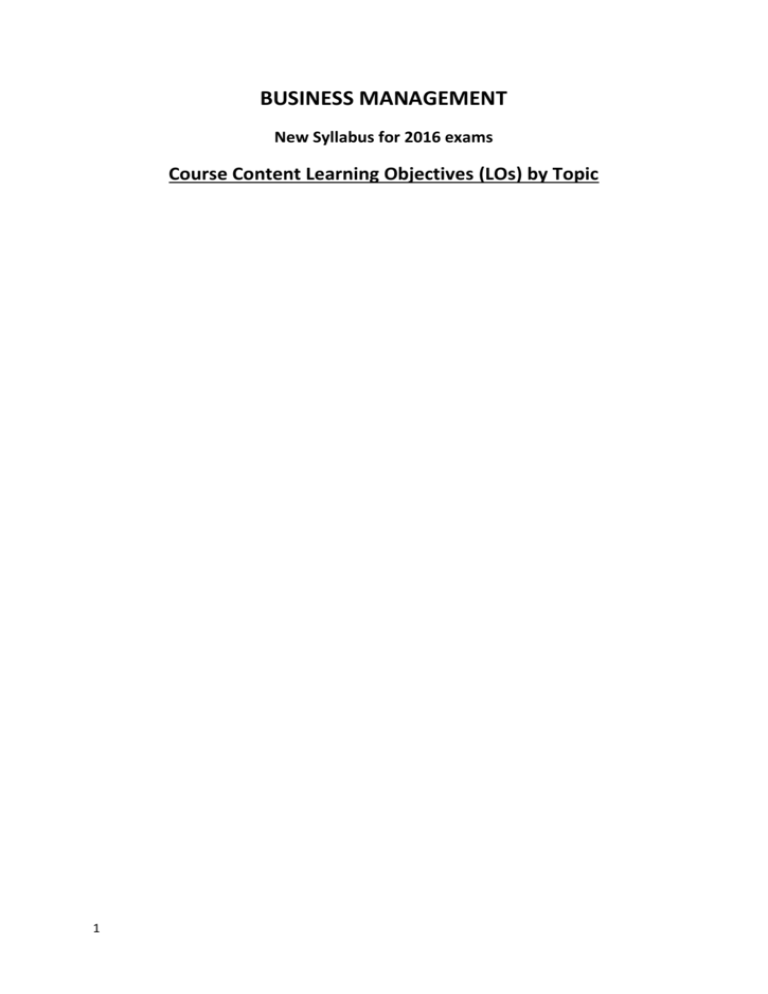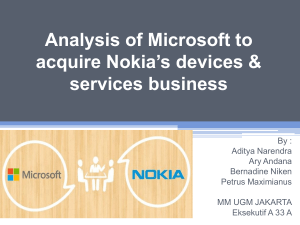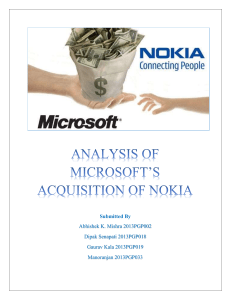1. Review Questions
advertisement

BUSINESS MANAGEMENT New Syllabus for 2016 exams Course Content Learning Objectives (LOs) by Topic 1 Unit 1 BUSINESS ORGANIZATION AND ENVIRONMENT Introduction to business management Define businesses as combining human, physical and financial resources to create goods and services using a relevant example Describe the various business functions (HR, finance and accounts, marketing and operations) with examples o How is Nokia organized in terms of their business functions? Explain the nature of business activity in different sectors: primary, secondary and tertiary o What sector of the economy does Oxford Fish Farms serve? Analyse the impact of sectoral change on business activity in the sector o Identify two changes within the telecommunications sector of the economy (e.g. growth of mobile phones and Internet telephony) and how are these changes affecting business organizations? (use what you know about economic sectors, business functions, or types of organizations to answer this) Explain the concept of value-added and how entrepreneurs and intrapreneurs add value to organizations o Pick an entrepreneur, such as Richard Brandon, and explain the success of their business in terms of how the business or service adds value (e.g. Virgin Air and the other Virgin businesses are successful because they provide value-for-money). o Contrast intrapreneur with and entrepreneur using an example. Explain the reasons for starting a business o Make a list of the most common reasons a person might start a business o What are the steps in the process of starting a business? o Identify problems that a new business might face. o Explain the elements of a business plan Types of organization 2 Distinguish between organisations in the private and public sector o How do the objectives of commercial organizations differ from organizations in the public sector? Identify the key features of for-profit (commercial) organizations: sole traders, partnerships, companies and corporations. Give examples. o Distinguish (how different) sole trader, partnership, companies and corporations with examples for each. Identify the key features of for-profits social enterprises. o What How Why: cooperatives, microfinance providers, and public-private partnerships (PPP). Give examples. Identify the key features of non-profit social enterprises. o What How Why: non-governmental organizations (NGOs) and charities. Give examples. Organizational objectives 3 Explain the importance of the vision and mission statements for an organization. o What How Why: vision statement, mission statement. o Use SMART mnemonic. Distinguish between aims, objectives, strategies and tactics and how they relate to each other (fit together). o State possible objectives for the Microsoft/Nokia merger, e.g. develop products for the smart phone market (Ansoff Matrix) o What might be the long-term strategy for Microsoft to accomplish the objective you state (use the Ansoff Matrix) o Identify a tactic (short term plan or action) that Microsoft might use to accomplish the objective you state. Explain how organizations need to change their objectives and innovate in response to changes in the external and internal environments. o How might Nokia need to change its objectives given their experience with Microsoft since 2011? What is corporate social responsibility (its’ nature)? Explain how the role of CSR is evolving o What How Why: ethical objectives? o What role(s) might ethical objectives play in a technology organization like Nokia versus a product focused company like Nestles? (Hint: for what purpose is the technology used?) o (Analyse the advantages and disadvantages of ethical objectives and discuss their impact.) What is SWOT analysis? Be able to identify the strengths and weakness of a given firm, and the opportunities and threats it faces in its market. What how why: Ansoff matrix (growth strategies)? o Analyse the growth strategies of Oxford Fish Farms using an Ansoff matrix. Stakeholders Explain the interests of internal and external stakeholders. o In the Microsoft/Nokia merger, who are the internal and external stakeholders and what are their “interests” (means what can they win or lose?) Examine possible areas of conflict between internal and external stakeholders. o Given the plan to strategically align with Microsoft, how might the internal stakeholders for Nokia be in conflict? (Hint: identify 3 main stakeholder groups and discuss the risk v reward for each). External environment Prepare a STEEPLE analysis for an organisation and use it to analyse the impact of changes in any of the STEEPLE factors on the objectives and strategy of a firm. Give examples. o For Microsoft or Nokia, pick one, what external factors are driving change in the organization? (USE STEEPLE and Driving Forces analysis.) Growth and evolution 4 Explain how economies and diseconomies of scale can impact the growth and evolution of a firm. o What How Why: economies of scale o What economies of scale can Microsoft bring to a strategic alliance/merger with Nokia. (Give examples.) Compare the advantages and disadvantages of large and small organizations o (Book learning and the IB Rule of Three) Rapid decision-making, flexibility and ability to change direction are characteristics of… while economies of scale, established revenue streams and goodwill are characteristics of … Explain the difference between external and internal growth. o How can Microsoft enter the smartphone market through internal growth, and how through external growth? Explain with examples external growth methods. o What How Why: merger, acquisition, takeover, joint venture, strategic alliance and franchise o The following are examples of what: Nokia/Microsoft; Jaguar-Landrover (UK)/Chery(China); MacDonald’s (ADD two more examples of each) Discuss the impact of globalization on the growth and evolution of business o (Heads up: this LO speaks directly to two course concepts (Paper 2 section C) so it is an especially important LO) o We’ve talked a little bit about containerization and economies of scale in business – what part does economies of scale play in globalization? o What How Why: multinational companies o (Book learning) Evaluate the possible impact of multinational companies on the host company (good/bad, positive/negative, synergistic, etc). Give examples. Organizational planning tools only Use the following planning tools in a given situation: fishbone diagram, decision tree, force field analysis, and GANTT chart. (others we will use in future case studies) o Examine the value of using Force Field Analysis for the Microsoft/Nokia merger (interpret the results). o Apply cost/benefit analysis (decision making processes) or Force Field Analysis to the Microsoft/Nokia strategic alliance 2011 and evaluate the value of the tool. How does it help? For Later o Later cases - Compare and contrast scientific and intuitive decision making processes o Later cases - Construct and interpret decision trees and evaluate their value as a decision making tool 5





